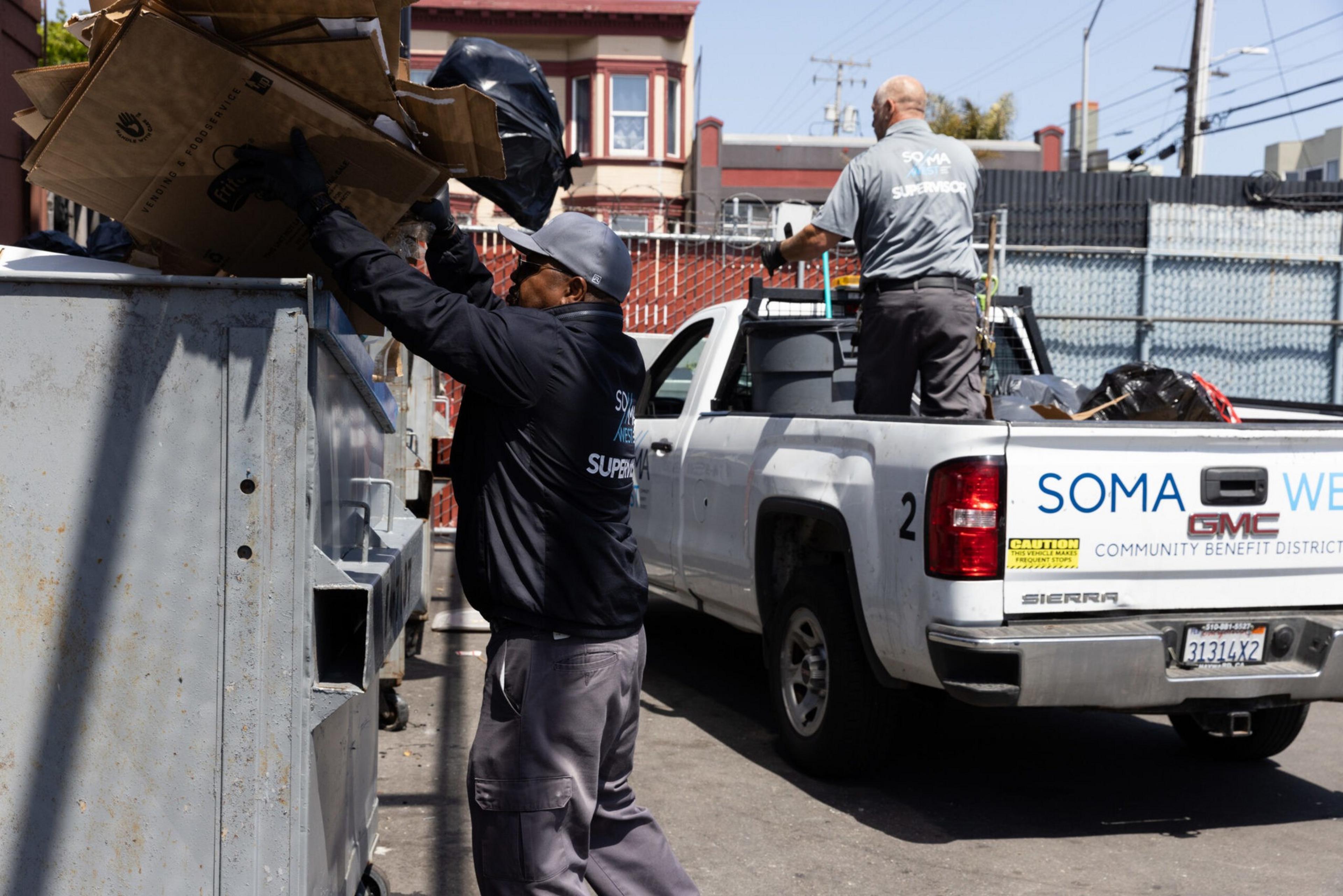“See this Code Brown? I’m sending it to one of the workers now,” said cleaning team leader Ken McCarter as he paused to look at a pile of feces on a San Francisco street in the South of Market neighborhood. McCarter snapped a picture with his phone and shot off a cleaning request.
The alert would be received by an ambassador with the SoMa West Community Benefit District nonprofit. Ambassadors are paid a starting rate of roughly $22 an hour, plus hazard pay. But especially gross tasks like feces cleanup command a premium: Workers bag $3 for every “Code Brown” they scrape off the streets.
“It’s the scavenger hunt from hell that my team has to play every day,” said Christian Martin, executive director of the nonprofit. “Seriously, there’s not enough [public restrooms], when you’ve got thousands of people living on the streets.”

The Standard hung out with a group of street cleaners from the community benefit district on June 1. The team was equipped with brooms, rolling garbage bins, walkie-talkies and a dump truck named Big Bertha.
“I learned the hard way that if you’re giving a flat rate for the hour, and your job has, say, 10 [Code Browns] to pick up, eventually you’re going to start ‘not seeing’ those shits,” Martin said. “That’s nasty work, so we were like, ‘We gotta incentivize people to start doing the dirty work.’”
If the data is anything to go by, SoMa West’s incentive program works. Workers dealt with 617 Code Browns in April 2020, the first month of the organization’s operations. A year later, the number of Code Browns cleared had shot up sixfold, for a whopping 3,771 cleaned in April 2021.
Martin has run the neighborhood’s top cleaning and community-building organization since the pandemic started. Over time, he says, street cleanliness issues have grown increasingly dire and gross.
The ambassadors have a variety of tools and techniques to approach the tasks at hand.
“Honestly, it depends on the [situation]. We’re in the weeds, and it’s gross,” said Ed Moore, a SoMa West cleaning supervisor. “If it’s liquid, rinse it off. Solidified, used to be liquid? That might need power. If it’s a log, that’s like picking up dog poop: plastic bag.”
The SoMa West CBD was formed in March 2020 with the explicit purpose of beautifying and cleaning the neighborhood’s streets. Like many of San Francisco’s other community benefit districts, the SoMa West organization has since expanded to include other services like homeless outreach, graffiti abatement and bulk cleanup.

READ MORE: They Shift Tons of Trash From San Francisco’s Streets. You’ve Never Heard of Them
“We’re like right there, neck and neck with the city, picking up trash,” said Moore. “They try to figure out how in the hell that we’re doing it.”
On our afternoon with the SoMa West cleaning team, The Standard learned about their tightly run operations: With at least three staggered cleaning and safety shifts from 5 a.m. to 2:30 a.m., workers will trawl each street, corridor, pocket and corner of the CBD’s 100-block territory.
“Our pressure washer guy, he’s out here early in the morning,” Martin said. “He starts here at 5 a.m., in some areas where there’s no residents.”

The SoMa West CBD is the largest of such organizations in San Francisco, and it’s the biggest geographical CBD west of Texas, according to its representatives. The organization has built intricate tracking systems—including its own 311-style reporting app—to better understand dirty hot spots in its neighborhood.
Now three years into its operations, the SoMa West CBD picks up enough trash annually to outweigh an A380, the world’s largest passenger airliner. In April alone, workers pulled over 35 tons of garbage (opens in new tab) off city streets, according to the nonprofit’s data.
It’s not just cleaning; the street ambassadors seem to know everyone in SoMa. On our walk, folks near encampments and neighborhood legends like Rudy Corpuz all recognized the SoMa West workers from their distinct navy blue uniforms.

Martin says many of the workers on his team have untraditional backgrounds or had a hard time finding employment elsewhere. Now, they do some of the city’s most important work and, by far, its dirtiest.
“I’m not looking for a handout; I’m looking for a hand up,” said Moore, who served over 30 years in prison for murder before joining the nonprofit. He says he came to San Francisco, where he didn’t know anyone, to have a fair shot at life.
“I’m a supervisor. I got a 2019 Honda; I got a one-bedroom apartment right around the corner from the job,” Moore added. “You gave me the chance of an opportunity, and I’m gonna give you 110% every day. It’s really been a blessing for me.”

